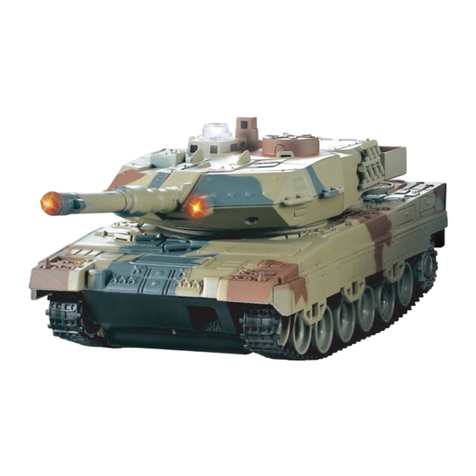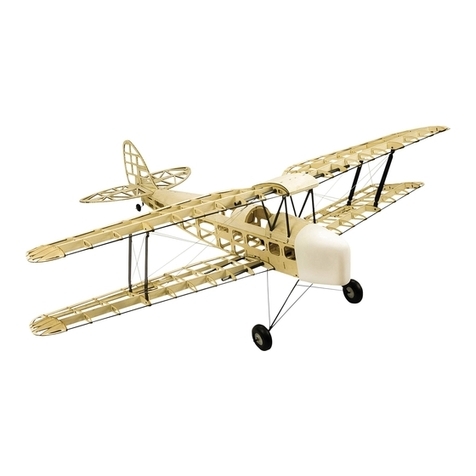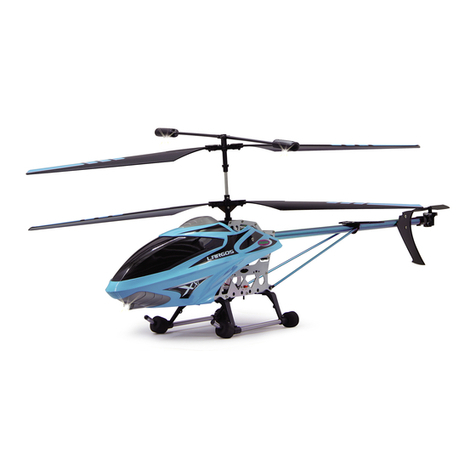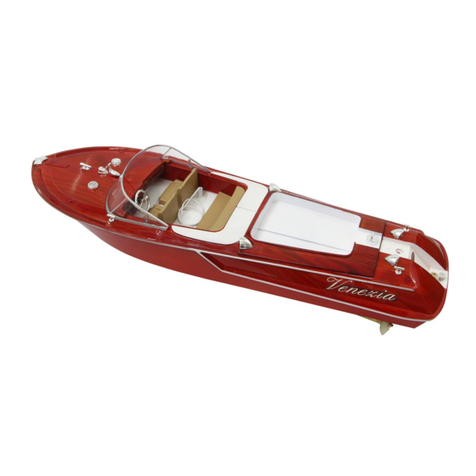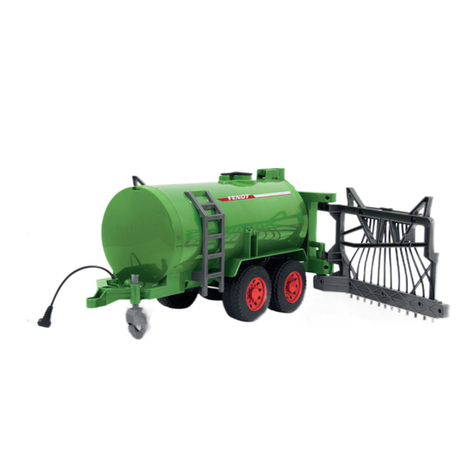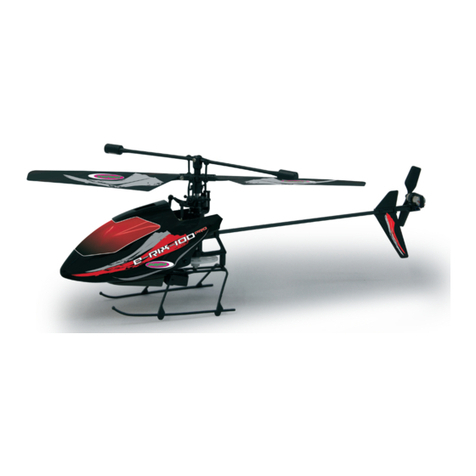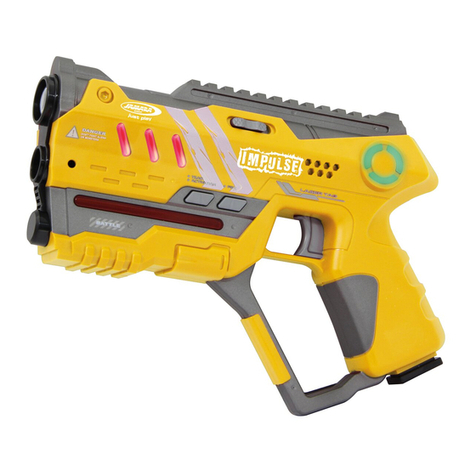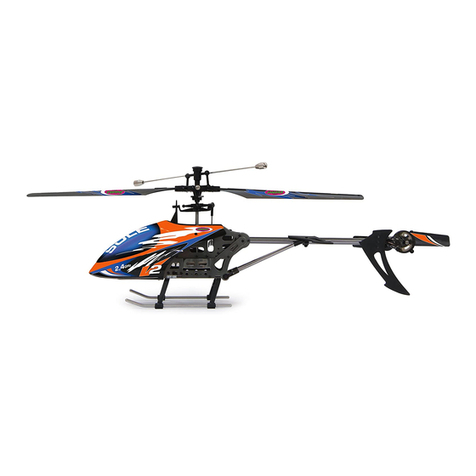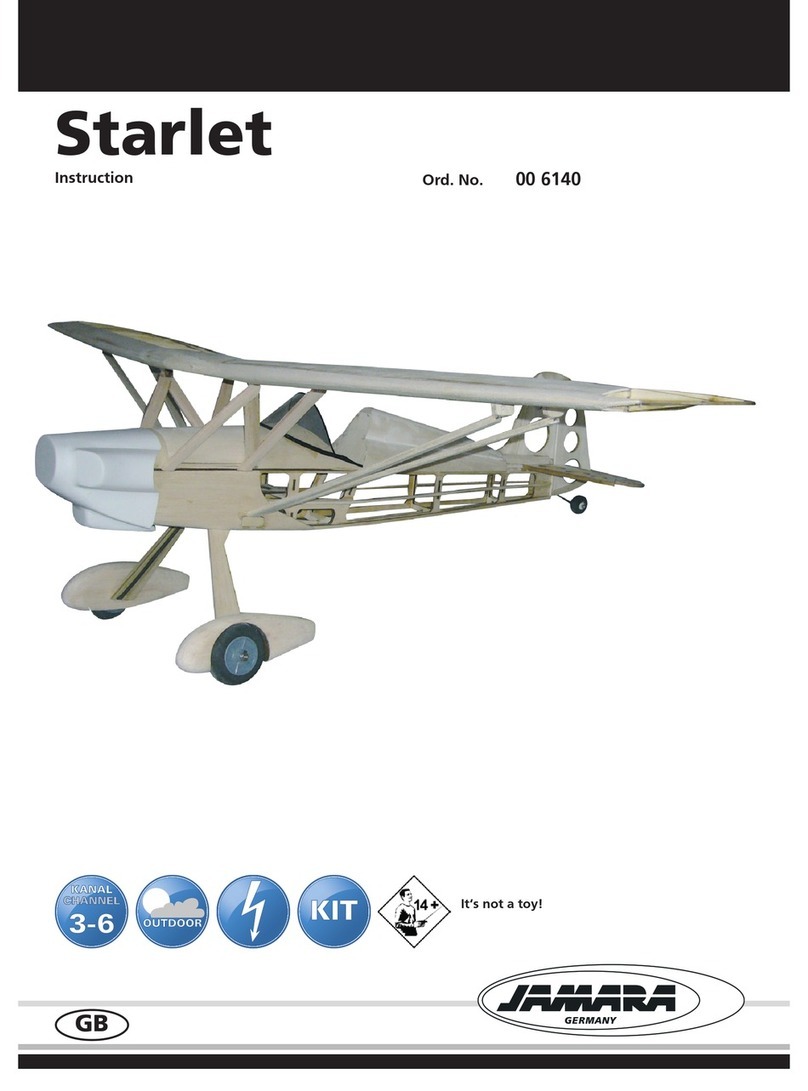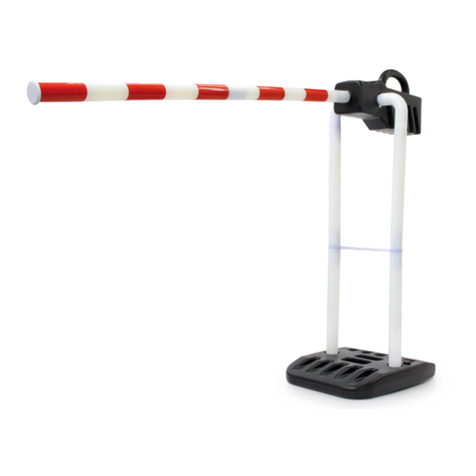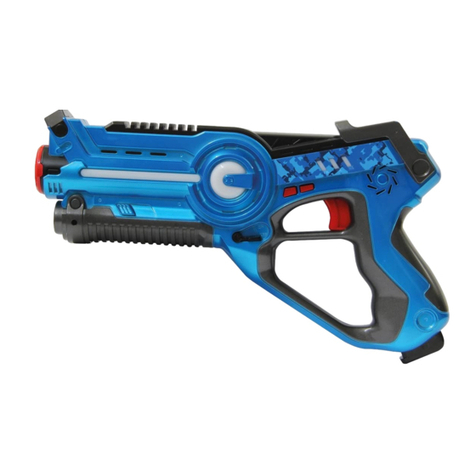
2
DE
Inbetriebnahme und Binden
Der Empfänger in Ihrem Modell ist mit ei-
ner Einschalt-Sicherheitsfunktion versehen.
Das garantiert, dass das Modell nur bindet
wenn es ein gültiges Sendersignal erhält.
Die korrekte Vorgehensweise ist wie folgt:
Schalten Sie das Modell ein. Dabei sollte
das Modell auf einer ebenen Fläche stehen,
damit sich das Gyrosystem während des
Bindens initialisieren kann. Die LEDs an
den jeweiligen Enden beginnen zu blinken.
Stellen Sie den Gashebel auf die unterste
Position (kein Gas) und schalten Sie den
Sender ein.
Zum initialisieren schieben Sie den Gas-
hebel ganz nach oben und wieder zurück.
Während des Fluges blinken die grünen
vorderen LED´s um Ihnen die Flugrichtung
anzuzeigen. Wenn im Flug zusätzlich die
roten LED´s blinken signalisiert Ihnen das
Modell das der Akku leer ist und geladen
werden muss.
Für den Transport sind die Steuerhebel
ausgesteckt und stecken im Sendergehäu-
se. Vor der Inbetriebnahme entnehmen Sie
die Steuerhebel aus dem Sendergehäuse.
Stecken Sie die Steuerhebel erst nach dem
Schließen des Sendergehäuses ein.
GB
Start to y and binding
Your RC model is tted with a Power-On
failsafe. This is designed to ensure that
the helicopter’s motor will not start unless it
detects a suitable radio-control signal. The
correct Start-Up sequence is as follows:
Switch on the model and place this on a
spacious at ground, at this time avoid
moving the helicopter so the radio and gyro
system can initialize. The LED on the mo-
del blinks.
Make sure that the throttle stick are at the
bottom (no throttle is given) and turn on the
transmitter.
For instalation put the gas pedal to the top
and back. During ight the front green LEDs
will light up for direction. Once the red LEDs
light up the model is indicating that the bat-
tery pack needs charging.
For transport reasons the control sticks are
unplugged and plugged in the transmitter
casing. Before ying, remove the control
sticks from the transmitter casing. Only
plug-in the control sticks after closing the
transmitter casing.
FR
Synchroniser le modèle avec l‘émetteur.
Le récepteur de votre modèle est équipé
d‘une fonction de sécurité. Cela garantit
que le modèle se connecte uniquement si
les signaux de l’ émetteur sont valides. La
procédure à suivre est la suivante:
Allumez le modèle. Pendant l’opération
le modèle devra se situer sur une surface
plane de sorte que le gyroscope puisse
s’initialiser pendant la synchronisation. Les
lumières LED à la n des branches com-
mencent à clignoter.
Poussez la manette des gaz jusqu’ à la po-
sition la plus basse (pas de gaz). Allumez
le récepteur.
Pour l’initialisation, poussez le manche des
gaz complètement en avant puis retour:
Pendant le vol les LEDs vertes de devant
clignotent pour vous montrer la direction de
vol. Quand les LEDs rouges clignotent en
vol le modèle vous signale que l’accu est
vide et doit être chargé.
Pour le transport les leviers de comman-
de sont enlevés et mis dans la boite de
l’émetteur. Avant de la mise en marche en-
levez les leviers de commande de la boite
de l’émetteur. Veuillez mettre les leviers ap-
rès avoir fermé la boite de l’émetteur.
IT
Avvio + binding del trasmettitore al mo-
dello
La ricevente del modello è dotato di una
funzionalità di accensione di sicurezza.
Questo garantisce, che il modello reagisce
solo quando riceve un segnale valido dal
trasmettitore. La procedura corretta è la
seguente:
Il modello si accende. In questo caso, il
modello dovrebbe essere su una supercie
piana in modo che il giroscopio può inizia-
lizzarsi correttamente. I LED del modello
cominciano a lampeggiare.
Portare l‘acceleratore nella posizione più
bassa (gas a zero). Accendere il trasmit-
tente
Per inizializzare premere la leva del gas
no sopra e tutto il tragitto indietro: Durante
il volo, il LED anteriore verde lampeggiano
per mostrarla la direzione di volo. Se in volo
anche i LED´s rossi lampeggiano le segnala
che la batteria del modello e scarica é deve
essere ricaricata.
Per il trasporto sono scollegati le leve di
controllo che sono collegate nella custodia
della radio. Prima della messa in funzione,
togliere la leva di controllo della custodia
della radio. Collegare la leva di controllo
solo dopo aver chiuso la custodia della
radio.
ES
El primer uso + Enlazar la emisora con
el modelo
El receptor de su modelo está provisto de
una función de seguridad de encendido. De
esta forma garantiza, que el modelo sola-
mente se enlaza, cuando recibe una señal
de transmisión correcta. La forma correcta
de comenzar es la siguiente:
Encienda el modelo.In questo caso, il mo-
dello dovrebbe essere su una supercie
piana in modo che il giroscopio può inizializ-
zarsi correttamente. Los LEDs comienzan a
parpadear.
Baje el stick del acelerador del todo (ningu-
na aceleración). Encienda la emisora.
Para iniciar, presione la palanca de gas
hacia arriba y nueve mente hacia atrás: Du-
rante el vuelo, el LED frontal verde parpa-
dean para mostrarle la dirección de vuelo.
Si en el vuelo además los LED´s rojos par-
padea, el modelo le señala que la batería
esta vacia y se debe cargar.
Para motivos de trasporte, las palancas de
control estan desenchufados y estan en-
chufados en la caja de emisora. Antes de
la puesta en marcha, quite la palanca de
control desde la caja de emisora. Ponga la
palanca de control solo despues de cerrar
la caja de emisora.
DE - Sender
Um die Batterien einzulegen müssen Sie
zuerst den Halteclip entfernen. Er ist nur an
2 Haltenasen eingeklemmt und kann leicht
entfernt werden. Nach dem Batterien ein-
gelegt wurden (auf Polarität achten), muss
dieser Halteclip wieder angebracht werden
um die Batterien an Ihrem Platz zu halten.
Ladevorgang am Sender
Die Fernsteuerung und das Modell müssen
ausgeschaltet sein. Die Ladestation an der
Fernsteuerung leicht nach oben ziehen und
das Modell auf die Ladestation stecken. -
Während des Ladevorgangs leuchtet die
Lade-LED. Wenn die Lade-LED erlischt, ist
der Ladevorgang abgeschlossen.
Nach etwa 40 - 60 min. ist der Ladevorgang
abgeschlossen, die Flugzeit bei vollgelade-
nen Akku beträgt ca. 5 - 10 Min.
Achtung:
Sollte die Lade-LED nicht leuchten ist
das Modell entweder schon vollgeladen
oder der Kontakt zur Ladestation unter-
brochen. Sollte letzteres der Fall sein be-
wegen Sie das Modell während es an der
Ladestation hängt etwas hin und her bis
die LED leuchtet.
GB - Transmitter
To insert the batteries, you have to remove
the holding clip rst. It is clamped only at
two retaining lugs and can be easily remo-
ved. After the batteries are inserted (obser-
ve the polarity). the retaining clip must be
retted to keep the batteries at its place.
Charging on the transmitter
The radio control and modell must be swit-
ched off. Move the charging station on the
remote control upward. Plug-in the model
onto the loading station of the remote con-
trol. The Charge-LED will light up during
charge. When the LED will light off the char-
ging process is completed.
The charging process should take approx.
40 - 60 min. and should give you approx.
5 - 10 min. ying time.
Attention:
In case the charging LED does not light
up, then the model is either fully charged
or the contact to the charging station is
interrupted. In case of an interruption,
move the model once attached to the
charging station for the LED to light up.
FR - Radiocommande
Pour pouvoir mettre les piles, il faut d’abord
enlever le clip. Il est xé avec deux supports
nez et l’enlèvement est très simple. Après
avoir mis les piles (respectant la polarité), le
clip doit être xé.
Processus de charge au travers de
l’émetteur
La radiocommande et votre modèle doivent
être éteints. Tirez la station de charge de la
radiocommande un peu vers le haut et met-
tez le modèle sur la station de charge de la
radiocommande.
La charge est complète après environ 40 -
60 minutes et la durée de vol est de l‘ordre
de 5 - 10 minutes.
Attention :
Quand la LED de chargement n’éclaire
pas, le modèle est chargé entièrement
ou le contact à la station de charge est
coupé. Au cas cité dernier veuillez agi-
ter le modèle pendant il est connecté
avec la station de charge jusqu’à la LED
s’allume.
IT - Trasmittente
Per inserire le batterie deve rimuovere le
clip. E incastrato solo a due linguette e puó
essere facilmente rimorso. Dopo che le bat-
terie sono state inserite (rispettando la po-
larità), si deve rimontare il supporto clip per
mantenere le batterie al suo posto.
Ricarica tramite trasmittente
Il radiocomando e il modello devono esse-
re spenti. Tirare la stazione di ricarica alla
radio leggermente verso sopra e collegare
il modello nella stazione di ricarica della
radio. Il LED sul trasmettitore si accende
durante la carica. Appena completata la
carica, il LED si spegne.
La ricarica é completata in 40 - 60 min‘ e la
durata del volo é mediamente di 5 - 10 min.
Attenzione:
Se il LED di ricarica non brilla può essere
che il modello e già completamente cari-
cato o il contatto alla stazione di ricarica
è interrotto. Qualora quest’ultimo sia il
caso, deve muovere il modello mentre e
collegato alla stazione di ricarica un po’
in avanti e indietro no a quando il LED
si accende.
ES - Emisora
Para inserir las baterías hay que quitar el
clip. Esta engrapado en dos soportes y se
puede quitar fácilmente. Después de poner
las baterías (respetando la polaridad), este
clip debe ser reajustado para mantener las
baterías en su lugar.
Carga en la emisora
El mando a distancia y el modelo deben
estar apagados. Asegúrese de que tanto la
emisora y el modelo están apagados. Tire la
estacíon de carga en la emisora ligermente
hacia arriba y conectar el modelo en la es-
tación de cargar de la emisora.
El proceso de carga es de unos 40 - 60 min.
minutos y permitirá un rango de vuelo de
entre 5 - 10 min.
Atención:
Si el LED de carga no brilla puede ser
que el modelo esta ya completamente
cargado o el contacto con la estación de
carga se interrumpe. Si este es el caso
tienen que mover el modelo mientras
esta conectado en la estación de carga
un poco hacia atrás y adelante hasta que
el LED se ilumina.
DE - Flugübungen
Bevor Sie iegen informieren Sie sich zu-
erst über seine Steuerfunktionen und führen
einige Übungen durch. Platzieren Sie das
Model mit der Hinterseite zu Ihnen zeigend
(schwarzen Rotorblätter) auf einer ebenen
Fläche. Üben Sie zuerst den Schwebeug
mit dem Gasknüppel zu kontrollieren. An-
schließend versuchen Sie die Position des
Models mit Hilfe des rechten Steuerknüp-
pels zu verändern (vorwärts, rückwärts und
seitwärts) und gegebenenfalls abzufangen.
Zuletzt sollten Sie das Drehen des Models
um die eigene Achse mit dem linken Steu-
erknüppel üben. Wenn Sie die Grundfunk-
tionen des Models beherrschen können
Sie sich an Ihren ersten kontrollierten Flug
machen.
GB - Practice simulation ight
Before ying with the model check rst
about its control functions and perform
some exercises. Place the model with the
back facing to you (the black blades) on a
at surface. Practice only to hover with the
throttle control. Then, you try to change the
position of the model using the right stick
(forward, backward, sideways) and possibly
correct the ight. At last, you should practice
turning the model around its own axis with
the left stick. If you are into the basic func-
tions of the model you can perform your rst
controlled ight.
FR - Voler dans la pratique
Avant de faire voler le modèle, informez
vous de toutes ses fonctions de contrôle et
faîtes quelques essais. Placez le modèle
sur une surface platte, placez vous derriè-
re le modèle(les hélices noires). Essayez
de le faire planer avec la manette des gaz.
Ensuite essayez de changer la position du
modèle à l’aide de la manette droite (mar-
che avant, marche arrière, sur les cotés). Si
vous contrôlez toutes les fonctions de base
du modèle vous pouvez faire les premiers
vols.
IT - La pratica
Prima di volare il modello, consigliamo fare
conoscenza con tutte le funzioni di controllo
e di effettuare i primi voli di test. Posizionare
il modello su una super cie piatta, davanti
al pilota. Le eliche del modello devono es-
sere in posizione posteriore. Per primo, pro-
vare ad alzare il modello in volo, e tenerlo
“fermo” in volo. Poi provare a cambiare la
posizione del modello utilizzando la levetta
destra (per farlo andare in avanti/indietro e
destra/sinistra). Appena imparato le funzioni
di base, procedere ad effettuare i primi voli.
ES - Volando en la práctica
Antes de volar con el modelo, se recomi-
enda conocer todas la funciones de control
y hacer el primero vuelo de prueba. Posi-
cionar el modelo en una supercie plana,
en frente del pilota (las palas negras ). Las
palas del modelo deben estar en la posición
trasera. En primo lugar, pruebe a desp-
egar el modelo en vuelo, y tener jo en el
vuelo. A continuación, intente a cambiar
la posición del modelo usando la palanca
derecha (para que vas hacia adelante/atrás
y izquierda/derecha). Cuando se ha apren-
dido las funciones básico, proceda con los
primero vuelos.
white forward white forward
21 3 4
DE - Trimmen
Lassen Sie das Modell ruhig auf einer Stelle
schweben und beobachten Sie die Verän-
derungen beim betätigen der jeweiligen
Trimmtasten.
GB - Trimming
Let the model hover in one spot and watch
the changes in the respective by pressing
the trimm buttons.
FR - Trimmer
Laissez planer le modèle à une certaine
hauteur et observez les changements
quand vous actionnez les régulateurs du
trimmage
IT - Trim
Fare volare il modello ad una certa altezza
e osservare i cambiamenti quando si preme
i regolatori dei trim.
ES - Trim del modelo
Flotar tranquilamente el modelo y observar
los cambios mientras pulses el regulador
de trim.
white
right
left
white
forward
backward
white forward
DE
1. Turbo-Taste
Das Modell verfügt über 3 Ge-
schwindigkeiten. Um die Ge-
schwindigkeit zu wechseln drü-
cken Sie kurz die Turbotaste an
der Senderrückseite.
2. Flipmodus
Drücken Sie die Flip-Taste und
lassen Sie sie wieder los. An-
schließend wählen Sie mit dem
rechten Steuerknüppel in welche
Richtung das Modell den Flip aus-
führen soll.
GB
1. Turbo button
The model has 3 speed options.
To change in-between the speed
options, press the Turbo button
on the backside of the transmitter.
2. Flip mode
To execute a ip, press the ip
button once. Once the ip button
is pressed, move the right con-
trol stick in the direction the Flip
should be performed.
FR-
1. Touche Turbo
Pour changer la vitesse appuyez
en peu de temps la touche Turbo
au verso de l’émetteur.
2. Mode Flip
Pour faire un Flip appuyez sur
la touche Flip et la lâchez direc-
tement. Ensuite vous choisissez
avec le levier de commande droi-
te dans quelle direction le modèle
doit faire le Flip.
IT
1. Pulsante Turbo
Il modello ha 3 velocità. Per
cambiare la velocità premere e
lasciare il pulsante Turbo sul retro
della radio.
2. Modalità Flip
Per eseguire un ip, premere il
tasto Flip e lasciarlo. Subito dopo
scegliere con la leva di controllo
destra in quale direzione il model-
lo deve eseguire il Flip
ES
1. Botón Turbo
El modelo tiene 3 velocidades.
Para cambiar la velocidad, pre-
sione el botón turbo en la parte
posterior de la emisora.
2. Modo Flip
Para realizar un Flip pulse el
botón Flip y déjalo. Inmediata-
mente después elija con la pa-
lanca de control derecha en cual
dirección el modelo tiene que
hacer el Flip.
21
-
-+
+
